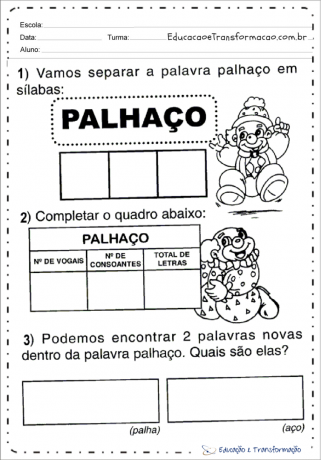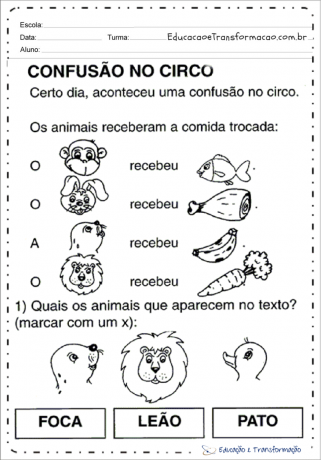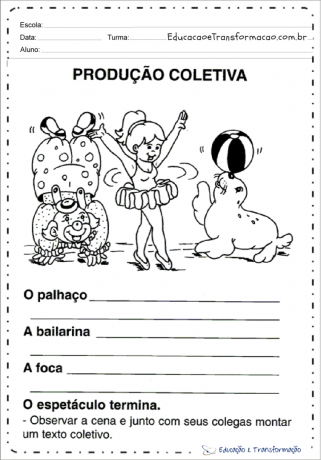
We selected in this post several suggestions for Circus Day Activities for Elementary School, ready to print and apply in the classroom or as a homework assignment.
O Circus day is celebrated annually in March, 27 th. This date serves to honor this type of entertainment that delights children and adults of all ages.
March 27 was chosen as Circus Day in honor of the Brazilian clown Abelardo Pinto, popularly known as Piolin, who was born on that date in 1897. Piolin was considered a great clown, who stood out for his enormous comic creativity and skill as a gymnast and tightrope walker.
More in:
He became world famous and was even honored during the Week of Modern Art in 1922, by Tarsília do Amaral, Mário de Andrade, Oswald de Andrade and Anita Malfati.
Teachers from all over Brazil use this commemorative date to work with students from the initial grades and, thinking about it, we selected some Circus Day Activities for Elementary School, check out:
Index
Life in the circus – Read and answer:
Read the text and answer:
Look at the image below:
Answer:
The clown
the white clown
Others in: Didactic Sequence – Circus Day Activities
The Circus Day Activities for Elementary School, below, are recommended for 1st and 2nd year students.




Math: Connect each figure the right amount.

little clown sapeca


Also check: 52 mural ideas for Circus Day

the juggler– Make different lines on the floor: straight, wavy, curved, circles and others. The proposal is for children to play walking on top of the risk in different positions such as: tiptoeing, only with your heels, with your hands on your head, with your hands on your hips, holding a glass of water, etc. - without leaving the scratchs.
The dancer – The proposal is as the teacher is reading the text, the children must perform the aforementioned movements. In a second moment, putting music chosen by the teacher on the stereo, we suggest instrumental, so that children can dance, rhythmically, freely.
One step here…
One step over there...
Running forward and back into place,
Palms I'm going to clap,
I'll jump,
A very beautiful wheel,
Running with friends,
Running in place.
The proposal is to put a mattress on the floor, train somersaults with the help of the teacher. Place hula hoops around and play jumping in and out, alternating, etc. Place benches or chairs and play climbing and descending. Playing jumping with one foot, planting banana trees, turning stars (according to class level). Play at balancing light objects on sticks.
Reading the poem to the students and interpreting the poem with the children, trying to understand what they really understood about it and revealing the children's previous knowledge on the subject; increase the vocabulary of students from words that are still unknown; Imitate the clown developing body, facial and theatrical expression; draw the clown; naming the clown and preparing a collective story about him; put a melody in the poem and sing it, dramatizing it with the students.
Oh! Happy people!
Nobody gets sick.
See the clown?
What good thing.
He runs,
Back flips,
Jump and scream,
laugh and cry,
When tells anecdote.
the mouth is big
And red,
The face is white,
like flour
All the children sitting on the floor in a circle, the teacher distributes balls and explains the game, explaining: throw the ball in the air and try to catch it; play the ball from one hand to the other; now throw in the air, clap your hands once and catch the ball.
A rope tied to the ceiling. In this game, the teacher helps all the children to climb. Many can do this on their own.
This is the favorite! The teacher puts mattresses on the floor and asks the children to roll over trying to do the somersault. Those who cannot do it alone, the teacher helps.
This activity isn't exactly a craft for kids, but they'll see the result of their handicrafts in their peer's face. Divide the kids into pairs and give them some makeup, each one will paint their pair's face so everyone is ready to play the clown! You can ask the children to imitate the clown's expressions, making happy or sad faces.
Divide the children into pairs, while one lies on a mat, the other uses a juggling ball to massage the child's back. After a few minutes the pair reverses functions. Besides being very nice, this is a relaxing social activity to calm the children down after the game.
Make your own stilts using metal cans (the size of powdered milk). Drill two holes on both sides of each can, near the bottom. Measure the string so that its size is appropriate for children. Thread one end of the rope into each hole and tie from the inside. To walk on stilts, children must climb onto the cans, holding the string in their hands. It's not easy, but this activity helps children's motor development!
working with history

Circus Day Activities for Elementary School -


Circus Day Activities for Elementary School - Circus Project
Subscribe to our email list and receive interesting information and updates in your email inbox
Thanks for signing up.

